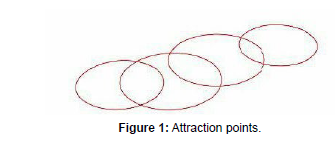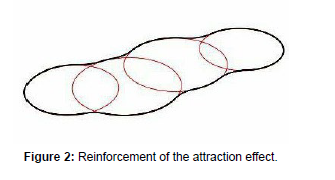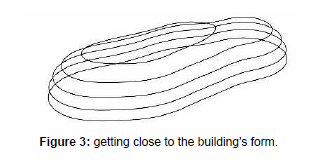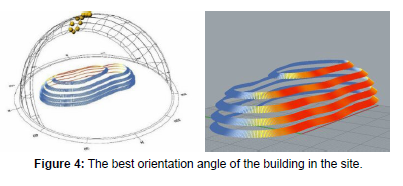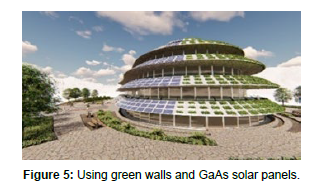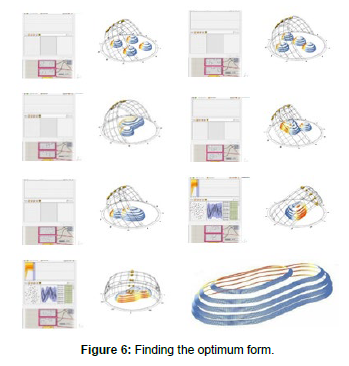Solar Building Design Using GaAs PV Cells for Optimum Energy Consumption
Received: 03-Nov-2023 / Manuscript No. iep-23-119204 / Editor assigned: 06-Nov-2023 / PreQC No. iep-23-119204 (PQ) / Reviewed: 20-Nov-2023 / QC No. iep-23-119204 / Revised: 23-Nov-2023 / Manuscript No. iep-23-119204 (R) / Accepted Date: 28-Nov-2023 / Published Date: 30-Nov-2023 QI No. / iep-23-119204
Abstract
Gallium arsenide (GaAs) solar cells are widely used in applications, like spacecraft and satellites because they have a high absorption coefficient, efficiency and can withstand high energy particles such as electrons and protons. With the energy crisis there's a growing need for efficiency and cost effective solar cells. GaAs cells with their 46% efficiency compared to silicon cells 23% can be utilized in buildings to achieve nearly zero emissions. This way we can make use of irradiation and convert more solar energy into electricity. III V semiconductors used in these cells offer performance compared to other technologies available. However despite these advantages Si cells dominate the market due to their prices. In our study we took an approach by using software from the start to gather all information. By doing we aimed to design the optimal building that harnesses the full potential of solar energy. Our modeling results reveal a future, for GaAs cells I utilized the Grasshopper plugin, for modeling and optimization purposes. To assess radiation, weather data, solar energy levels and other factors I relied on the Ladybug and Honeybee plugins. We have shown that silicon solar cells may not always be the choice, for meeting electricity demands particularly when higher power output is required. Therefore when it comes to a power consumption and the available surface area for photovoltaic (PV) installation it may be necessary to consider efficient solar cell options, like GaAs solar cells. By taking into account the building requirements and utilizing GaAs technology we were able to optimize the PV surface area.
Keywords
Gallium arsenide (GaAs); Optimization; Sustainable building; GaAs solar cells
Introduction
The current energy crisis is placing significant strain on power plants and causing energy prices to soar. However, this presents an excellent opportunity for the expansion and enhancement of installed photovoltaic systems, much like previous crises, such as the one in the 1970s. Furthermore, the European Union has implemented a program aimed at achieving climate neutrality by 2050 [1-3]. This ambitious goal can be accomplished through the utilization of high-quality photovoltaic cells that are effectively connected [4-6], in conjunction with the integration of intelligent photovoltaic systems [4].
Gallium arsenide is a highly utilized material in semiconductor technologies due to its appealing properties. It has gained significant popularity in high electron mobility transistor (HEMT) structures because it eliminates the need for momentum change during the transition between the valence band and the conductivity band, and does not require collaborative particle interaction. In comparison to the significantly higher electron mobility, whole mobility in GaAs is similar to that of silicon. This means that devices requiring the collaboration of hole and electron motion have the same response times. GaAs also has a direct band gap of 1.42 eV, making it suitable for diode and photovoltaic cell applications. To enhance its properties, GaAs is often alloyed with aluminum to create AlxGa1−xAs through precise melting of the two elements together. One benefit of having a wide band gap is that the material maintains its semi conductive properties even at higher temperatures. For instance, silicon, which has a bandgap of 1.12 eV, remains semi conductive even at elevated temperatures. As the temperature increases, the generation of carriers through thermal means becomes more significant compared to the intentionally doped carriers [5-11].
GaAs photovoltaic cells are classified as compounds belonging to the III-V group. In the year 2000, the Nobel prize-winning Russian physicist Zhores Alferov was recognized for his valuable contribution to GaAs in the area of heterostructures [1].
Si-based solar cells are currently the most popular choice in the solar energy market due to their affordable production cost and average efficiencies. The maximum efficiency that can be achieved by a singlejunction Si solar cell is 29.4% according to theoretical calculations [9]. Currently, the highest laboratory efficiency of a Si cell stands at 26.1%, which is nearing its theoretical limit. However, single crystal III-V solar cells have shown significantly higher efficiencies of up to 39.5% under 1-sun conditions through the use of monolithically grown multi-junction structures [12,13].
Solar cells can have a maximum of eight thin layers, each designed to absorb light of a specific wavelength. These types of photovoltaic cells are known as multi-junction or cascade solar cells. They are fabricated using tandem technology and are sometimes referred to as tandem cells. Each layer consists of a unique composition and material with a specific bandgap that allows them to capture light in a particular spectral region. Typically, the upper layer of the material possesses a wide bandgap and is responsible for capturing the majority of the visible spectrum. On the other hand, the lower layer has a smaller bandgap and is capable of absorbing light in the infrared region [14- 19].
GaAs-based solar cells are widely utilized in the aerospace industry due to their ability to capture a broader range of light wavelengths in space compared to Earth. They are also utilized in the aviation and military sectors because of their versatility and lightweight design. They are particularly beneficial for unmanned aerial vehicles (UAVs). Additionally, they are used in concentrators; enabling solar cells to function efficiently even under extremely high temperatures.
Applications of Solar Cells
GaAs and multi-junction PV cells are primarily utilized in specific industries that demand high efficiency, durability, or lightweight properties. These advanced technologies are designed for specialized applications [17-26].
Aerospace and military
High-altitude long-endurance UAVs, also known as experimental solar-powered aircraft, are designed to stay airborne for extended periods of time, even up to several months. These innovative UAVs are equipped with flexible solar cells, allowing them to harness the power of the sun and eliminate the need for launching expensive satellites into orbit. UAVs can be utilized for various purposes such as mapping, surveillance, border patrol, and search and rescue operations. In civilian applications, they are employed as airborne cell phone towers and communication tools. Research and development in the field of unmanned aerial vehicles (UAVs) and solar cells have been ongoing for more than two decades, with continuous advancements being made [7,25].
Solar photovoltaic concentrators
GaAs PV cells and solar concentrators are frequently employed together. Solar concentrators are devices that use optical elements to focus light, typically sunlight, onto a central point, which is a solar cell. Concentrator photovoltaics (CPV) quantify concentration intensity by measuring the number of Suns or ratios. When the light intensity on the solar cell surpasses 10 Suns, passive cooling becomes essential for the PV cell. Typically, when the light intensity on the solar cell goes beyond 10 Suns, it becomes essential to employ passive cooling for the PV cell. This setup is known as a low-concentration photovoltaic system (LCPV), and it allows for the continued use of silicon solar cells. When the brightness surpasses 100 times the intensity of the sun, the solar cell needs to be cooled using a cooling liquid. At this point, it is classified as high-concentration photovoltaics (HCPV). The specific threshold may differ based on different sources. GaAs and multilayer structures are commonly used for such high-performance concentrators [14].
Solar cells that are designed for concentrator applications, like the InGaP/GaAs/InGaAs inverted triple-junction, are also specifically tailored for CPV (concentrator photovoltaic) systems. In a study conducted by Sasaki et al., these solar cells achieved an impressive efficiency of 45% [20].
Space probes, satellites, and other space objects
GaAs-based solar cells have been widely utilized on space satellites, probes, and other objects due to their ability to withstand gamma radiation. This is particularly important as GaAs exhibits a higher resistance to such radiation. The initial spacecrafts that contained solar cells made of GaAs were utilized in the Soviet Venera program for the purpose of investigating the Venusian surface [2]. On November 12, 1965, the spacecraft Venera 2 was launched from the Baikonur cosmodrome. It was followed by Venera 3 on November 16, 1965. While Venera 3 is commonly believed to be the first human-made object to impact a foreign planet, there is disagreement about this claim due to an earlier signal loss, as pointed out by Leverington [16]. There is, therefore, a lack of certainty regarding whether the touchdown occurred with the surface.
The Hubble telescope, a well-known device, also utilizes GaAs solar cells. In 2002, during Servicing Mission 3B, GaAs solar arrays measuring 7.1 × 2.6 m were installed, replacing the previous silicon panels [10]. EMCORE Corporation has developed an innovative use for triple-junction solar cells in the Orion Multipurpose Crew Vehicle (MPCV), a spacecraft service module designed by NASA. This cuttingedge technology will be utilized in the upcoming Artemis 1 mission, scheduled for November 2021, during which the spacecraft will travel around the Moon [8].
Factors in PV Design
PV design factors refer to the different elements that greatly influence the energy output of a PV system. These factors are crucial in determining the performance of the system. When assessing a site for PV installation, several factors need to be taken into account. These include the location of the site, the weather conditions (such as solar irradiation level, seasonal snow cover, and rain patterns), the presence of shade, the expected level of soiling, the condition and load-bearing capacity of the roof, the existing electrical load, the orientation of the roof, and the available space. All of these factors play a significant role in evaluating the feasibility and efficiency of installing a PV system at a particular site [22].
The Major PV System Factors
During the initial planning stage, certain features of PV modules, like the tilt and azimuth angle, are considered. Typically, panels with a lower tilt generate more energy during the summer months, while those with a higher slant produce more energy during the winter. The optimal fixed angle for maximum output lies between these two extremes [12]. In the realm of energy harvesting, the spacing between modules holds great importance. It is highly probable that shading will occur between rows in photovoltaic arrays, which can result in decreased efficiency of the system.
The efficiency and energy production of a PV system greatly depend on its components and various factors. These factors are essential for estimating the system's performance before conducting a detailed analysis by a specialist. Several factors contribute to the overall performance of a solar power system. These include the temperature of the cells, the ratio between DC and AC sizes, the temperature coefficient, the efficiency of the inverter, and various system losses such as mismatch, snow, dust, soiling, and wiring. These characteristics play a crucial role in determining how well the system functions. You can calculate the efficiency of converting solar energy into electricity and the overall efficiency of the solar power system by using the information and estimates provided in Table 1 [24].
| Categories | Factors |
|---|---|
| Building and site | Roof shape and slope |
| Available space | |
| Inner shading | |
| Surroundings shading | |
| Weather | Solar motion |
| Solar insolation (direct, diffused and reflected) | |
| Sky cover rate | |
| PV module layout | Tilt angle |
| Azimuth | |
| Module spacing | |
| PV system | Panel efficiency |
| Inverter efficiency | |
| Wiring loss | |
| Finance | Soft and hard costs |
| Benefit and profit | |
| Return on investment | |
| Payback period |
Table 1: The factors that affect the efficiency and energy production of a PV system.
In 1977, in Denmark pioneered the development of zero-energy buildings [15]. Further explored these buildings in various climatic conditions. These innovative structures utilized energy conversion and renewable energy technologies to meet the energy needs of the buildings [18]. Furthermore, these types of buildings not only make use of the remarkable insulation properties, but they also incorporate photovoltaic panels and biomass energy sources as primary energy generator [26]. Three different configurations are employed for incorporating photovoltaic panels into the building, with the most frequently used application being the installation of these panels on the building's roof. Panels can be used in vertical walls and also in doubleglazed windows as alternative forms of arrangement [23].
Obtaining the Optimal Design and Use of GaAs Solar Panel
The goal of this project is to enhance the utilization of sunlight through GaAs solar panels, thereby maximizing energy absorption and ultimately optimizing buildings to achieve zero-energy status. It is evident that this structure effectively eliminates the production of greenhouse gases, thereby minimizing energy usage.
Utilizing this particular design and method is suitable for various climate conditions, making it adaptable to different regions around the world. The process of determining the most optimal positioning for GaAs panels involved employing mathematical programs to complete each phase successfully.
The Optimization of the Process
To attain the ideal architectural structure, the Rhino software's Grasshopper plugin was employed, alongside the utilization of the Ladybug plugin within the Grasshopper interface to extract essential climate data specific to that region. The Honeybee plugin was employed for assessing daylight brightness, optimizing energy usage, performing thermal simulations, and determining the loads of the building. Furthermore, it facilitated the creation of detailed executive plans for various elements including facades. Additionally, the Galapagos plugin was utilized to optimize data obtained from the Ladybug plugin in order to enhance overall efficiency.
To create the structure, the Grasshopper plugin employed Metaball logic. Four points acted as attraction points on the project site's screen (Figure 1), freely moving and interacting with each other. As these points approached one another, their mutual attraction intensified and reinforced their influence (Figure 2).
In order to discover the optimal shape, the heights of the points were taken into account. This involved considering how far they moved along the z-axis or deviated from the point of attraction, as their effectiveness decreased with greater distance. To discover the ideal geometric shape, the algorithm was provided with variable x and y values for the attraction points. Altering these parameters resulted in a shift in the points' positions on the screen of the website. The algorithm was provided with the conditions of the foundation and floors area, as well as the distance from the site's edge in the following step. The algorithm was provided with the conditions of the foundation and floors area, as well as the distance from the site's edge in the following step. By employing the Genetic algorithm in Grasshopper and taking into account the various form states, a thorough optimization process was conducted to attain the desired form. These involved modifying input parameters until the intended outcome was achieved (Figure 3).
To determine the optimal orientation angle on the site, data on solar insolation was obtained from the weather station at Mehrabad airport. Using the Ladybug plugin, the ePW file containing weather information specific to the project's location was analyzed. The solar insolation angle was then determined for each season at 12 pm, when it is most perpendicular to the surface. Finally, a mean vector was calculated based on these findings (Figure 4).
Located in Tehran, Iran, the structure served as a prominent physics facility. With an annual radiation average of 4.58 kwh/m2, Tehran experiences significant solar exposure. The building spans roughly 8000 square meters and requires appropriate lighting and thermal management to accommodate the available space efficiently. (Figures 5 and 6) By taking into account the average yearly radiation of 4.58 kwh/m2 in Tehran, along with the efficiency of GaAs solar cells and the surface area allocated for these cells, as well as the mean annual radiation coefficient for Tehran, it becomes possible to compute both the electricity generated per square meter in Tehran and within a specific building. These calculations can then be used to compare consumption levels with production outputs.
Determining the Electricity Generation Capacity of GaAs and Silicon Cells
The electricity generated per square meter is determined by multiplying the average daily radiation, as recorded in the table, by the efficiency of GaAs cells. The average overall radiation tilt coefficient is used to calculate this value, which is equal to 1.23. The software calculates that the surface area where the panel is installed in the building measures 960 square meters. Installation of solar cells is done on both the building's façade and roof, resulting in a daily electricity production of 2487.7 KW/day for GaAs and 1243.8 KW/day for silicon. The annual electricity production for a GaAs panel amounts to 908,010.5 kw/Year.
Based on the electricity generation of 2487.7 KW/day from GaAs cells and the building's consumption rate of 2395 KW/day, it is clear that the building consumes less electrical energy than what is produced by the GaAs cells. However, when comparing it to the electricity generated by silicon cells, the consumption surpasses production. Consequently, it can be inferred that for this particular building, GaAs cells are the sole viable option for electricity generation.
Examining the Excess of Produced Electrical Power
Upon analyzing the outcomes of the excess electricity produced by GaAs and silicon cells, it is evident that the surplus exhibited a linearly negative trend in the case of silicon. To put it differently, the silicon cells do not meet the building's energy requirements, necessitating an alternative source to fulfill a portion of its electricity consumption. Conversely, GaAs cells yield a surplus, meaning they generate more power than required to fully supply the building with electricity.
Considering the Investment Potential of GaAs Solar Cells
The cost of GaAs solar panels per square meter varies among different suppliers. This research has extracted the average price from a selection of vendors, which amounts to $3,152 per square meter. Considering that the building requires a total surface area of 960 square meters for its panels, the investment needed for GaAs solar systems will be $3,025,920.
We demonstrated that silicon solar cells are not always the optimum solution for building electricity needs especially when we need more power. Therefore, considering a given power consumption, based on available PV surface, there might be need for higher efficiency solar cells such as GaAs solar cells. We were able to optimize PV surface based on the building needs considering GaAs solar cells technology.
Cost-Benefit Analysis
As each PV module receives varying levels of radiation, the return on investment would differ for each individual module. By conducting a cost-benefit analysis, one can determine the optimal investment level in energy generation based on a specific payback period. The first step in performing the cost-benefit analysis is to determine the number of PV modules that have a solar potential higher than a given threshold. Then, the value of energy provided by PV modules at each threshold is quantified. To quantify the value of the generated solar energy, it is important to consider inflation and present value concepts [21].
Therefore, the PV energy revenue is calculated using Eqs. (1) and (2).

ER1: Energy revenue up to year n,: Discount factor up to year,:Unit cost of energy ($/kWh),: Amount of received radiation by PV module i (kWh), N: Number of modules,: Size of the module ,: Efficiency of the PV module (%), By conducting a cost-benefit analysis, one can determine the optimal investment level in energy generation based on a specific payback period.

Where: R: Discount rate, g: Inflation rate, n: Number of years in the period and g: Inflation rate.
The complete expense of photovoltaic (PV) modules, however, encompasses both the initial cost (acquisition and installation) and the ongoing maintenance cost, as shown in Equations 1. In order to calculate the maintenance cost accurately, it is essential to incorporate both the inflation rate and the discount rate since this cost factors into the entire lifespan of the PV system.

Where: Total cost up to year n,: Initial Cost for module i,: Maintenance Cost ($) in year n,: Discount factor up to year n.
Conclusion
Currently, the most effective option for maximizing the utilization of sustainable energy lies in harnessing solar energy and converting it into electricity. By incorporating this innovative technology in the realms of architecture and construction, we not only fulfill a building's power needs but also create visually appealing structures. To accomplish this goal and create a BIPV structure, it is essential to integrate a photovoltaic system into the building's design and architecture. For successful integration, it is crucial to consider the photovoltaic as an integral part of the building right from the initial design phase. This approach allows for seamless coordination and integration between the photovoltaic systems and other components of the building, ensuring their proper functioning and effectiveness.
We demonstrated that silicon solar cells are not always the optimum solution for building electricity needs especially when we need more power. Therefore, considering a given power consumption, based on available PV surface, there might be need for higher efficiency solar cells such as GaAs solar cells. We were able to optimize PV surface based on the building needs considering GaAs solar cells technology.
It is clear that to achieve the desired outcomes in the design and construction of a photovoltaic integrated building, it is essential to have collaborative efforts between various disciplines such as architectural engineering, civil engineering, electrical engineering, and mechanical engineering. By utilizing GaAs cells in lieu of conventional ones, a future can be envisioned where buildings are self-sufficient in meeting their own electrical needs, thus eliminating the dependency on municipal power. This would lead to the development of intelligent and reliable structures that operate with zero energy consumption. By utilizing software for optimization and energy analytics, we successfully identified the ideal placement for solar panels, resulting in an energetically optimized building. Through a fresh perspective on the utilization of GaAs solar cells to determine the optimal positioning of panels on structures, we achieved peak efficiency using GaAs cells. Based on the findings of this research, it was determined that by incorporating GaAs solar panels measuring 960 m2 on both the facade and rooftop surfaces, a total electrical energy consumption of 2395kw/ day can be adequately met. Moreover, these panels are capable of producing an equivalent amount of energy totaling 2487kw/day. This environmentally-friendly solution not only avoids pollution but also proves financially viable with a return on investment projected in just over two years.
References
- Alferov ZA NobelPrize.org.
- Andreev VM (2003) GaAs and High-Efficiency Space Cells. In Practical Handbook of Photovoltaics: Fundamentals and Applications, Elsevier Inc: 417–433.
- Available online: https://ec.europa.eu/commission/presscorner/detail/en/ip_20_335 (accessed on 28 September 2022).
- Bagalini V, Zhao BY, Wang RZ, Desideri U (2019) Solar PV-Battery-Electric Grid-Based Energy System for Residential Applications: System Configuration and Viability. Research 3838603.
- Brozel MR, Stillman GE INSPEC (Information service) (1996) In Properties of Gallium Arsenide. IEE: 981.
- Chao L, Niu T, Gu H, Yang Y, Wei Q, et al. (2020) Origin of High Efficiency and Long-Term Stability in Ionic Liquid Perovskite Photovoltaic. Research 1–13.
- Colozza AJ, Scheiman DA, Brinker DJ (1998) GaAs/Ge Solar Powered Aircraft. SAE International: Warrendale.
- EMCORE Corporation Awarded Solar Panel Manufacturing Contract from ATK Space Systems|EMCORE.
- Feifel M, Lackner D, Schon J, Ohlmann J, Benick J, et al. (2021) Epitaxial GaInP/GaAs/Si Triple-Junction Solar Cell with 25.9% AM1.5g Efficiency Enabled by Transparent Metamorphic AlxGa1-xAsyP1-y Step-Graded Buffer Structures. Sol: 2000763.
- Garner R Observatory—Electrical Power.
- Ghandhi SK (1994) VLSI Fabrication Principles: Silicon and Gallium Arsenide. Wiley: 834.
- Gregg A, T Parker, and R Swenson (2005) “A ‘Real World’ Examination of PV System Design and Performance.” Conference Record of the Thirty-First IEEE Photovoltaic Specialists Conference: 1587–1592.
- Green MA, Dunlop ED, Hohl-Ebinger J, Yoshita M, Kopidakis, et al. (2022) Solar cell efficiency tables (Version 60). Prog. Photovolt: 687–701.
- Kasaeian A, Tabasi S, Ghaderian J, Yousefi H (2018) A review on parabolic trough/Fresnel based photovoltaic thermal systems. Renew. Sustain. Energy Rev: 193–204.
- Kosonen A, Keskisaari A (2020) Zero-energy log house–future concept for an energy efficient building in the Nordic conditions. Energy Build: 110449.
- Leverington D (2000) New Cosmic Horizons: Space Astronomy from the V2 to the Hubble Space Telescope. Cambridge: 507.
- Li J, Aierken A, Zhuang Y, Xu PQ, Wu HQ, et al. (2021) 1 MeV electron and 10 MeV proton irradiation effects on inverted metamorphic GaInP/GaAs/InGaAs triple junction solar cell. Sol. Energy Mater. Sol. Cells: 111022.
- Ma T, Javed MS, (2019) Integrated sizing of hybrid PV-wind-battery system for remote island considering the saturation of each renewable energy resource. Energy Conver. Manag: 178–190.
- Papež N (2021) Degradation of GaAs Solar Cells. Czech Republic.
- Sasaki K, Agui T, Nakaido K, Takahashi N, Onitsuka R, et al. (2013) Development of InGaP/GaAs/InGaAs inverted triple junction concentrator solar cells. In AIP Conference Proceedings; American Institute of Physics Inc: 22–25.
- Scheiman DA, Brinker DJ, Bents DJ, Colozza AJ (1994) Design of a GaAs/Ge solar array for unmanned aerial vehicles. In Proceedings of the Conference Record of the IEEE Photovoltaic Specialists Conference: 2006–2009.
- US Department of Energy (2014) “On-Site Commercial Solar PV Decision Guide.”
- Wang Y, Kamari ML, Haghighat S, Ngo PTT (2020) Electrical and thermal analyses of solar PV module by considering realistic working conditions. J. Therm. Anal. Calorim.
- Wijeratne W M, U Pabasara, Rebecca J Yang, Eric Too, and Ron Wakefield (2019) “Design and Development of Distributed Solar PV Systems: Do the Current Tools Work?” Sustainable Cities and Society: 553–578.
- Wojtczuk S, Reinhardt K (1996) High-power density (1040 W/kg) GaAs cells for ultralight aircraft. In Proceedings of the Conference Record of the IEEE Photovoltaic Specialists Conference: 49–52.
- Zhou Z, Feng L, Zhang S, Wang C, et al. (2016) The operational performance of ‘‘net zero energy building’’.: A study in China. Appl. Energy: 716–728.
Google Scholar, Crossref, Indexed at
Google Scholar, Crossref, Indexed at
Citation: Pouyafar H, Matin Aalaghmandan D, Vahidreza Yazdanpanah D (2023)Solar Building Design Using GaAs PV Cells for Optimum Energy Consumption.Innov Ener Res, 12: 355.
Copyright: © 2023 Pouyafar H, et al. This is an open-access article distributedunder the terms of the Creative Commons Attribution License, which permitsunrestricted use, distribution, and reproduction in any medium, provided theoriginal author and source are credited.
Share This Article
Recommended Journals
Open Access Journals
Article Usage
- Total views: 760
- [From(publication date): 0-2023 - Feb 22, 2025]
- Breakdown by view type
- HTML page views: 689
- PDF downloads: 71

